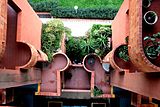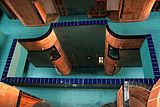Walden 7


Walden 7 is an apartment building designed by Ricardo Bofill Taller de Arquitectura and located in Sant Just Desvern near Barcelona, in Catalonia, Spain. It was built in 1975.[1]
Name
[edit]The name of the building is inspired by B. F. Skinner's novel, Walden Two, which depicts a utopian community and itself is a reference to Henry David Thoreau's novel Walden.[1] It is noted for its use of modules to create apartments and many public community spaces.[2]
Structure and usage
[edit]The original project includes 446 residences. With a budget lower than the norm for subsidized housing at the time, Walden 7 was built in the area to the west of Barcelona. It was originally designed as one of five similar blocks.[1] The building is composed of 18 towers which are displaced from their base, forming a curve and coming into contact with the neighbouring towers, described as a "vertical labyrinth with seven interconnecting interior courtyards."[3] The area originally devoted to communal uses was reduced to allow an increased number of apartments. These apartments are formed on the basis of one or more 28-square-metre (33 sq yd) modules,[1] which creates, on different levels, dwellings that range from single-module studios to large multiple-module apartments. Partitions between modules may be modified, designed to shift as family structures shift.[1]
Walden 7 was designed with small, uniform windows and no central heating. Its original design included a bath in the middle of the room, which most residents removed. The original exterior façade was covered with small, red ceramic tiles backed with the wrong adhesive, creating a pedestrian hazard as the tiles fell off the building.,[1][3] The local government began repairing the structure in the 1990s,[1] and a 1995 refurbishment removed most of the tiles and replaced them with red paint.[3] The only remaining tiles exist on the small balconies.[1] The interior is painted in blue, purple, and yellow.[2] It is accessible by tram; the stop near the building is called Walden.[4]
Although the building is a private apartment complex, it offers public tours.[4]
Reception
[edit]Walden 7 became instantly iconic and made the cover of the prestigious Architectural Design magazine in July 1975.[5]
In an article for Architectural Digest, architectural historian Vincent Scully described Walden 7 as "a wildly expressionistic apartment house, part Gaudí, part Archigram."[6]
In popular culture
[edit]In the 1993 film The Bilingual Lover, two characters live in Walden 7. The falling tiles are mentioned.[7]
See also
[edit]- Unité d'habitation
- La Muralla Roja
- Les Espaces d'Abraxas
- Antigone, Montpellier
- List of works by Ricardo Bofill Taller de Arquitectura
Gallery
[edit]Notes
[edit]- ^ a b c d e f g h King, Emily (2016-04-28). "Fortress of Solitude". Frieze. Retrieved 2019-08-27.
- ^ a b Naja, Ramzi (2013-02-22). "AD Classics: Walden 7 / Ricardo Bofill". ArchDaily. Retrieved 2019-08-30.
- ^ a b c "An Apartment Building Inspired By a Sci-Fi Utopia". Atlas Obscura. Retrieved 2019-08-30.
- ^ a b "Visit Walden 7 in Barcelona". Roca Gallery. 2018-03-19. Retrieved 2019-08-30.
- ^ Carson Chan (Spring 2014). "Ricardo Bofill, The Future of the Past: "I'm interested in my own history of errors."". MONO.KULTUR.
- ^ "Vincent Scully assesses the radical classicism of the Spanish architect's housing projects", Architectural Digest, 45 n4: S59(3), April 1988
- ^ "El Amante Bilingue/the Bilingual Lover (Novela (Booket Numbered)) (Spanish Edition)". Abe Books. Retrieved 2019-08-30.








